1. Component views
Rear axle
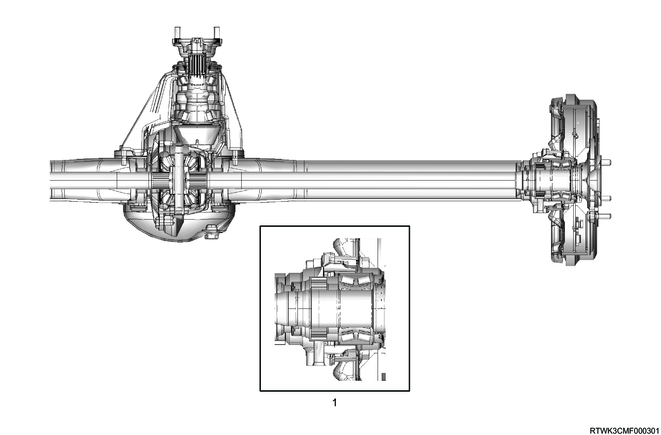
Part name
- ABS specifications
2. Rear axle installation
1. Temporary tightening (2WD (Except high ride suspension specifications))
1) Apply grease to the inside and outside of the rubber bushing.
2) Support the rear axle using a jack.
3) Install the following parts to the frame and leaf spring.
- Shackle plate
- Shackle
- Rubber bushing
Caution
- Temporarily tighten the shackle, and make sure to final tighten after lowering the vehicle.
Grease application and shackle installation

4) Apply engine oil to the threaded portion of the U-bolts.
5) Install the U-bolt to the rear axle.
Note
- Install the following parts.
- Lower clamp
- Seat
- U-bolt nut
Note
- Install the seat so that the installation angle is within the following standard range.
Tightening torque: 78 N・m { 8.0 kgf・m / 58 lb・ft }
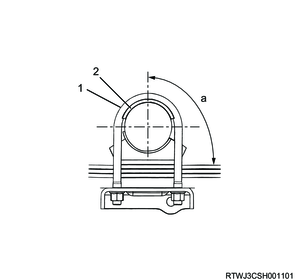
Legend
- U-bolt
- Seat
Standard value
a: 88 to 92 ° Seat tolerance range
2. Final tightening (2WD (Except high ride suspension specifications))
Caution
- Final tighten the shackle after returning the vehicle to the ground.
1) Final tighten the shackle.
Tightening torque: 98 N・m { 10.0 kgf・m / 72 lb・ft }
3. 2WD (High ride suspension specifications), 4WD
1) Support the rear axle using a jack.
2) Install the U-bolt to the rear axle.
Note
- Install the following parts.
- Lower clamp
- Bumper rubber
- U-bolt nut
Tightening torque: 78 N・m { 8.0 kgf・m / 58 lb・ft }
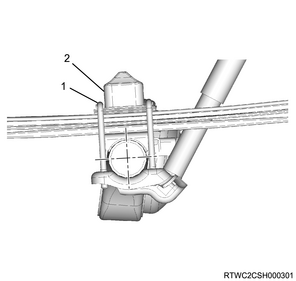
Legend
- U-bolt
- Bumper rubber
3. Shock absorber installation
1) Install the bushing to the shock absorber.
2) Install the washer and shock absorber to the frame and lower clamp.
3) Install the washer and nut to the frame and lower clamp, and temporarily tighten the nut.
4) Final tighten the frame side nut.
Tightening torque: 39 N・m { 4.0 kgf・m / 29 lb・ft }
5) Final tighten the lower clamp side nut.
Tightening torque: 39 N・m { 4.0 kgf・m / 29 lb・ft }
4. Rear wheel cylinder installation
1) Install the wheel cylinder to the back plate.
Tightening torque: 14 to 18 N・m { 1.4 to 1.8 kgf・m / 10 to 13 lb・ft }
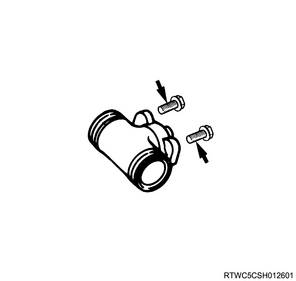
2) Connect the brake pipe to the wheel cylinder.
Tightening torque: 13 to 19 N・m { 1.3 to 1.9 kgf・m / 10 to 14 lb・ft }

5. Brake shoe installation
1) Apply grease to the brake shoe fitting section and back plate sliding section.

Legend
- Back plate sliding section
- Brake shoe fitting section
2) Install the brake shoe to the back plate.
Caution
- Do not damage the wheel cylinder dust cover.
- Make sure the wheel cylinder piston does not shoot out.
3) Install the lower spring to the brake shoe.
4) Install the upper spring to the adjuster.
5) Install the adjuster and upper spring to the brake shoe.
6) Install the following parts to the front brake shoe.
- Adjust lever
- Adjust lever ring
Caution
- Do not reuse the adjust lever ring.
7) Install the adjust lever spring to the adjust lever and brake shoe.
8) Install the shoe holder pin to the brake shoe.
Caution
- Do not reuse the shoe holder pin.
9) Install the shoe holding spring to the shoe holder pin.
Caution
- Do not reuse the shoe holding spring.
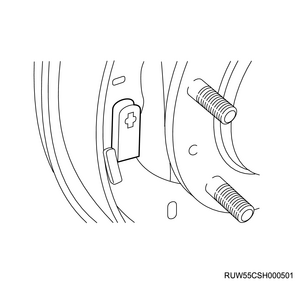
6. Parking brake cable connect
1) Install the parking brake cable to the back plate.
Note
- Install the inner cable to the back plate hole. Then install the case cap of the outer cable to the back plate.
2) Install the parking brake cable to the parking lever.
7. Brake drum installation
1) Install the brake drum to the rear axle shaft.
8. Wheel speed sensor installation
1. Preparations for wheel speed sensor installation (ABS specifications)
1) Clean the following sections.
- Sensor mounting hole inside and mounting surface of the sensor bracket
- Sensor bracket mounting surface of the knuckle
Note
- Clean foreign material, such as rust and sensor fragments.
- If any rust is found, remove it with a wire brush, etc.
Caution
- If using rust penetrant when removing the wheel speed sensor, clean the part with a parts cleaner, etc.
2. Precautions for wheel speed sensor installation (ABS specifications)
Caution
- When installing the sensor, use your hand to push the sensor installation flange until it is firmly attached to the installation surface, and then tighten the bolt.
- When inserting the sensor, do not pry or hammer it with a tool.
- Do not tighten the sensor body fixing bolts with an air tool, but temporarily hand tighten and then fully tighten them.
- After tightening the bolts, check that there is no clearance between the mounting flange and the mounting surface again.
- Install the sensor harness using the twist prevention line as a reference to avoid twisting.
- Take care not to pull the harness, which may result in it being cut.
- Confirm that there is no harness interference.
- Be careful not to damage the wheel speed sensor.
3. Installation (ABS specifications)
1) Install the wheel speed sensor to the rear axle case.
Tightening torque: 8 N・m { 0.8 kgf・m / 71 lb・in }
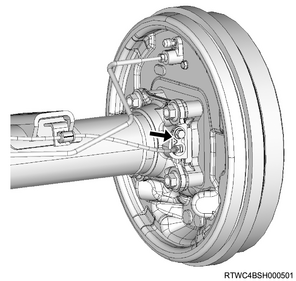
2) Connect the harness clip to the harness.
Tightening torque: 8 N・m { 0.8 kgf・m / 71 lb・in }
3) Connect the harness connector to the wheel speed sensor.
4. Inspection after vehicle restoration (ABS specifications)
1) Turn ON the ignition switch, and check whether the ABS warning light turns OFF after illuminating for approximately 3 seconds.
2) Start the engine and drive the vehicle straight forward from a stationary state. Slowly accelerate to 15 km/h {9.3 mph} and then slowly apply the brake until the vehicle stops. Check that there are no abnormal noises or problems with the braking force during this procedure.
3) Confirm whether the following symptom occurs during verification actions above.
- The ABS warning light illuminates, or does not illuminate.
- ABS operation noise or motor rotation noise is caused.
- Brake pedal kickbacks are felt.
- Desired braking force is not reached.
4) When the above symptom occurs, take the following action.
- Check the installation status of the wheel speed sensor and connection status of the connector.
- Check the DTCs, and perform inspection and take remedies for the ABS system in accordance with the diagnostic procedure for each DTC.
Caution
- Since the ABS rotates the motor for a moment right immediately after the vehicle is started, sound of rotating motor may be heard. This operation for initial confirmation task and not at fault.
9. Rear propeller shaft installation
1. Precautions when installing the rear propeller shaft
Caution
- Take care not to damage the spline yoke oil seal connection surface with other components when installing.
- Completely remove any dust or foreign material from the installation flange section of the flange yoke and final drive.

2. Rear propeller shaft installation (Two-piece type)
1) Install the propeller shaft to vehicle.
Note
- Install according to the alignment marks that were made during installation.
- Install in order starting from the front of the vehicle and moving rearward.
Tightening torque: 103 N・m { 10.5 kgf・m / 76 lb・ft }
2) Install the center bearing to the vehicle.
Tightening torque: 69 N・m { 7.0 kgf・m / 51 lb・ft }
3. Rear propeller shaft installation (One-piece type)
1) Install the propeller shaft to vehicle.
Note
- Install according to the alignment marks that were made during installation.
- Install in order starting from the front of the vehicle and moving rearward.
Tightening torque: 103 N・m { 10.5 kgf・m / 76 lb・ft }
4. Rear propeller shaft grease filling (4WD)
1) Fill the rear propeller shaft with grease from the following locations.
- The 2 universal joint locations
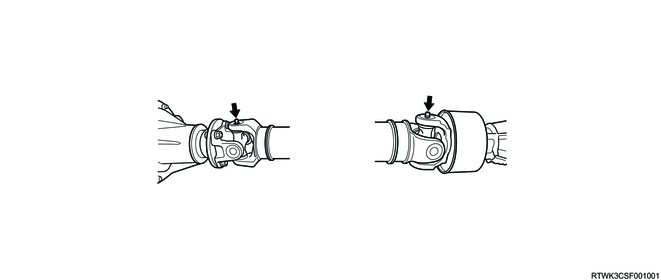
Caution
- Referring to the following, fill with grease regularly.
Refer to "201.General Information 14B.Vehicle Information maintenance schedule".
10. Cross member installation
1. Two-piece type rear propeller shaft
1) Install the cross member to the frame.
Tightening torque: 51 N・m { 5.2 kgf・m / 38 lb・ft }
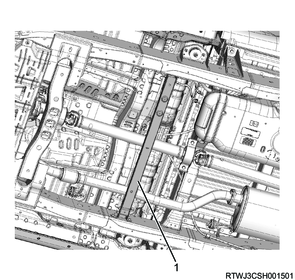
Legend
- Cross member
11. Disc wheel installation
1. Models with aluminum wheels
1) Temporarily tighten the disc wheel to the vehicle.
2) Lower vehicle.
3) Final tighten the wheel nut in the order shown in the diagram.
Tightening torque: 120 N⋅m {12 kgf⋅m / 87 lb⋅ft}
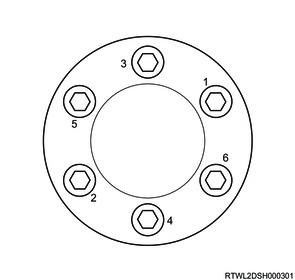
Caution
- After completing installation, make sure to further tighten the wheel nuts to the specified torque after the vehicle has been driven a distance exceeding the standard value.
Standard: 50 to 100 km { 31 to 62 mile }
4) Install the wheel cap to the disc wheel.
Note
- For models with 18-inch aluminum wheels, align the wheel cap groove with the air valve before installing.
5) Check that the surfaces of the wheel cap and wheel are flat.
Note
- If the surfaces are not flat, the wheel cap may fall off.
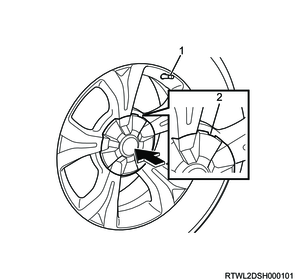
Legend
- Valve
- Wheel cap groove
2. Models with steel wheels
1) Temporarily tighten the disc wheel and wheel cap to the vehicle.
2) Lower vehicle.
3) Final tighten the wheel nut in the order shown in the diagram.
Tightening torque: 120 N⋅m {12 kgf⋅m / 87 lb⋅ft}

Caution
- After completing installation, make sure to further tighten the wheel nuts to the specified torque after the vehicle has been driven a distance exceeding the standard value.
Standard: 50 to 100 km { 31 to 62 mile }
12. Differential oil filling
1. Regarding lubricant refill amount and type
For the lubricant refill amount, refer to the following.
Refer to "204.Driveline, Axle 17B.Maintenance Information primary specifications of driveline, axle".
For the lubricant type, refer to the following.
Refer to "201.General Information 14B.Vehicle Information recommended fluids, lubricants and diesel fuels".
2. Rear final drive lubricant refill procedure
1) Install the drain plug and gasket to the rear axle.
Tightening torque: 78 N・m { 8.0 kgf・m / 58 lb・ft }
Caution
- Do not reuse the gasket.
2) Replenish the differential oil in the rear axle.
Note
- Fill oil up to the lower surface of the filler plug hole.
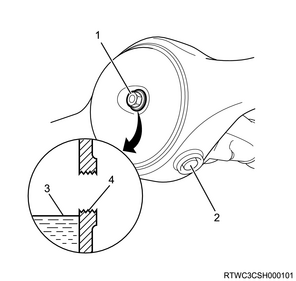
Legend
- Filler plug
- Drain plug
- Oil surface
- Hole lower edge
3) Install the filler plug and gasket to the rear axle.
Tightening torque: 78 N・m { 8.0 kgf・m / 58 lb・ft }
Caution
- Do not reuse the gasket.
13. Preliminary and post procedures
1. Post procedures
1) Connect the battery cable to the battery negative terminal.
2) Referring to the following, perform the setting of the front door power window switch with AUTO UP/AUTO DOWN function.
Refer to "9.Body, Cab, Accessories 9T.Glass, Windows, Mirrors front door power window switch setting".
3) Close the engine hood.
14. Brake fluid filling
The air bleeding procedure needs cooperation of 2 persons.
1. Precautions for brake fluid refill and air bleeding procedures
Caution
- In the following cases, refill with brake fluid and bleed the air.
- The brake pipe, brake hose, etc., have been disconnected.
- Air is in the hydraulic system.
- Brake fluid has been drained.
- The brake is used when the fluid level in the brake fluid tank is extremely low.
Caution
- Securely engage the parking brake during the air bleeding procedure.
- When refilling with brake fluid and bleeding the air with the tires in contact with the ground, move the vehicle to a level area, and set chock blocks in place at the tires.
- Always fill with new brake fluid.
- Fill with brake fluid to prevent the mixing in of air bubbles.
- To prevent intrusion of dirt, etc., clean the reservoir tank before removing the cap.
- Add brake fluid up to the tank MAX level before the air bleeding procedure to prevent air from entering.
- Do not fill the brake fluid tank with brake fluid over the MAX level.
- Continue to adding brake fluid to at least half the brake fluid tank during the air bleeding procedure.
The brake fluid tank is shared with the clutch fluid tank. Because a partition inside the tank causes the fluid amounts of the brake chamber and clutch chamber to be different, check the brake fluid on the brake chamber side.
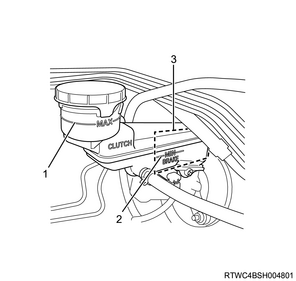
Legend
- MAX level
- MIN level
- Brake fluid chamber
Caution
- Bleed air until air has been fully discharged from the hydraulic system.
- Perform air bleeding procedures while maintaining sufficient brake fluid levels.
- Use the following brake fluid brands.
Refer to "201.General Information 14B.Vehicle Information recommended fluids, lubricants and diesel fuels".
Caution
- Do not use any brake fluid that contains petroleum components.
The rubber parts in the hydraulic brake system will expand or warp.
Caution
- Do not use any brake fluid container that contains petroleum components or that is wet with water.
If water has entered, the boiling point of the brake fluid will be lowered.
Caution
- Seal all containers to prevent them from getting dirty.
- Because the painted surface will be damaged, do not spill brake fluid on a painted surface.
- Bleed air from the brake fluid while the engine is running, and ventilate the room properly.
The vacuum brake booster may be broken if air bleeding is performed without starting the engine.
Caution
- Be sure to check the brake fluid level on the brake fluid chamber side.
The brake fluid tank is shared with the clutch fluid tank, and a partition inside the tank causes the fluid amounts of the brake chamber and clutch chamber to be different.
Caution
- For models with ABS specifications, remove the ABS slow blow fuse before performing the air bleeding procedure.
The ABS unit may be broken if air bleeding is performed without removing the ABS slow blow fuse.
2. Preparations for brake fluid refill and air bleeding procedures
Open the engine hood after pulling the parking brake lever.
1) Apply the parking brake.
2) Start the engine.
3) Remove the cap from the brake fluid tank.
4) Replenish the brake fluid tank with the brake fluid.
5) Perform the air bleeding procedure in the following order.
- Brake master cylinder (When the brake master cylinder has been removed)
- Left rear wheel cylinder
- Right rear wheel cylinder
- Left front brake caliper
- Right front brake caliper
Note
- If the brake fluid level is lowered or if air enters when the brake pipe is removed from the master cylinder, the air bleeding may be required at all 4 brakes.
- When brake pipes have been removed from any of the brakes, air bleeding must be performed for that wheel cylinder or caliper.
- If the piping is removed between the master cylinder and each brake, air bleeding of the operating brake system needs to be performed at the removed piping.
3. Air bleeding (Brake master cylinder)
1) Inspect the brake fluid level.
Note
- Refill the brake fluid as necessary.
- If the brake fluid has been filled, leave the system for at least 1 minute.
2) Disconnect the rear brake pipe from the brake master cylinder.
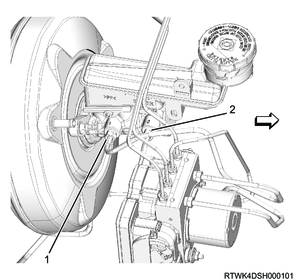
Legend
- Front brake pipe
- Rear brake pipe
3) Slowly depress the brake pedal once and hold it down.
4) Use a finger to completely plug the outlet of the master cylinder that is removed from the brake pipe, and slowly release the brake pedal.
5) Remove the finger from the outlet after the brake pedal has been completely returned.
Note
- Repeat the process mentioned above until the brake fluid comes out overflowing from the outlet.
Caution
- Be careful that the fluid level in the reservoir tank does not drop below the intermediate level indication.
6) Connect the brake pipe to the brake master cylinder.
7) Slowly depress the brake pedal once and hold it down.
8) Loosen the rear brake pipe.
9) Tighten the brake pipe again and slowly return the brake pedal.
Tightening torque: 13 to 19 N・m { 1.3 to 1.9 kgf・m / 10 to 14 lb・ft } Except ESC specifications
Tightening torque: 16 to 24 N・m { 1.6 to 2.4 kgf・m / 12 to 18 lb・ft } ESC specifications
10) Repeat the above procedure until no air is bled from the outlet when loosening the brake pipe.
11) Bleed the front brake pipe in the same way.
4. Air bleeding (Brake wheel cylinder or brake caliper)
Caution
- Bleed air 10 times or more for the front wheel, and 15 times or more for the rear wheel.
1) Apply an appropriate wrench to the bleeder.
2) Connect a clear tube to the bleeder.
3) Dip one end of the tube into a clear container filled with brake fluid.
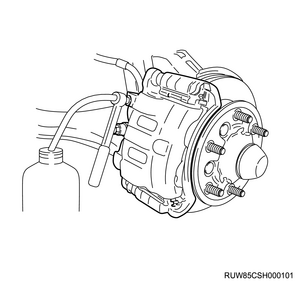
Note
- The container should be approximately 1/3 full of brake fluid.
4) Slowly depress the brake pedal 3 times with a speed of once per second and hold it down.

Legend
- Brake pedal
5) Loosen the bleeder approximately 1/2 a turn and bleed the air from the brake fluid.
6) Tighten the bleeder.
| Brake type |
Tightening torque |
| Front disc brake |
9 to 13 N・m { 0.9 to 1.3 kgf・m / 80 to 115 lb・in } |
| Rear drum brake |
6 to 8 N・m { 0.6 to 0.8 kgf・m / 53 to 71 lb・in } |
7) Release the brake pedal.
Caution
- Repeat the process mentioned above until no air bubbles are found in the discharged brake fluid.
- If brake fluid does not come out, discharge air from the master cylinder.
Air has entered the master cylinder.
5. Inspection after bleeding air
1) After air bleeding is complete, depress the brake pedal and check for any abnormal conditions.
2) Check the brake fluid level in the brake fluid tank, and fill the brake fluid tank with brake fluid as necessary.
Caution
- When filling, do not exceed the MAX level.
3) Depress the brake pedal and check for a sponge-like feeling.
Caution
- If feeling like a sponge, repeat the air bleeding process.
4) Stop the engine.
Note
- After completing the air bleeding procedure for the brake system, bleed the air from the clutch system as necessary.
5) Inspect all the brake pipes and brake hoses for the following.
- Wear
- Bending
- Damage
- Cracking
- Dent
Note
- Repair or replace if any abnormal conditions are found.
Caution
- Joints of all pipes and hoses can be easily damaged.
- Do not twist or bend the hose excessively when performing the procedure. Do not break the brake pipe when repairing or replacing the axle, suspension, etc.
- When installing the brake pipe or the brake hose, make sure to perform inspection.
- After removing the brake pipe or the brake hose, use a plug, tape, etc., to cover the opening and prevent the intrusion of foreign material.
6) Close the engine hood.
6. ABS slow blow fuse installation (ABS specifications)
1) Install the ABS slow blow fuse to the fuse box.
2) Turn ON the ignition switch and make sure the warning light turns OFF.
Caution
- Clear the DTCs that were set to the EHCU by removing fuses.
15. Rear drum brake adjustment
1. Rear drum brake lining gap adjustment (Except after overhaul)
All brakes are automatic adjustment type. The lining gap is automatically adjusted by repeatedly depressing the brake pedal.
1) Repeatedly depress and release the brake pedal until the click of the auto adjuster is not heard.
2) When the clicking sound can no longer be heard, depress the brake pedal 10 times to make sure that there is no stroke variation.
2. Rear drum brake lining gap adjustment (After overhaul, bench seat specifications)
1) Release the parking brake lever by moving it to the position where it is completely released.
2) Loosen the adjust nut using a wrench.
3) Repeatedly depress and release the brake pedal until the click of the auto adjuster is not heard.
Note
- If the clearance between the brake drum and the lining is adjusted to 0.5 mm {0.020 in}, the number of times of depressing the brake pedal can be reduced.
4) When the clicking sound can no longer be heard, depress the brake pedal 10 times to make sure that there is no stroke variation.
5) Remove the cover from the back plate.
6) Measure the gap between the brake drum and brake shoe.
Standard: 0.25 to 0.40 mm { 0.0098 to 0.0157 in } Lining clearance
Note
- If it is outside the standard range, inspect the adjuster.
7) Turn the adjust nut so that the parking brake lever is pulled up 6 to 9 notches when the lever is pulled up with the force of 294 N {30 kg/66 lb}.
Caution
- Make sure the brake does not drag.
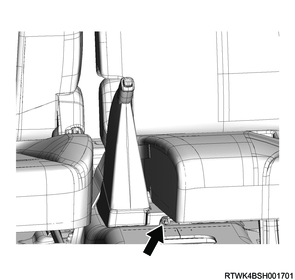
RHD models (LHD models are opposite)
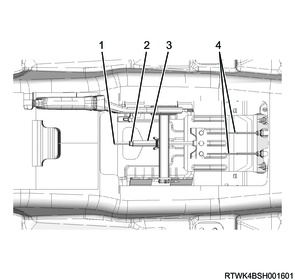
Legend
- Equalizer
- Adjust nut
- Spacer
- Parking brake cable
3. Rear drum brake lining gap adjustment (After overhaul, center console specifications)
1) Release the parking brake lever by moving it to the position where it is completely released.
2) Remove the cup holder from the console box.
RHD models (LHD models are opposite)
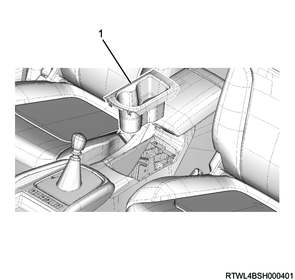
Legend
- Cup holder
3) Loosen the adjust nut using a wrench.
4) Repeatedly depress and release the brake pedal until the click of the auto adjuster is not heard.
Note
- If the clearance between the brake drum and the lining is adjusted to 0.5 mm {0.020 in}, the number of times of depressing the brake pedal can be reduced.
5) When the clicking sound can no longer be heard, depress the brake pedal 10 times to make sure that there is no stroke variation.
6) Remove the cover from the back plate.
7) Measure the gap between the brake drum and brake shoe.
Standard: 0.25 to 0.40 mm { 0.0098 to 0.0157 in } Lining clearance
Note
- If it is outside the standard range, inspect the adjuster.
8) Turn the adjust nut so that the parking brake lever is pulled up 6 to 9 notches when the lever is pulled up with the force of 294 N {30 kg/66 lb}.
Caution
- Make sure the brake does not drag.
RHD models (LHD models are opposite)

Legend
- Equalizer
- Adjust nut
- Spacer
- Parking brake cable
9) Install the cup holder to the console box.
RHD models (LHD models are opposite)

Legend
- Cup holder